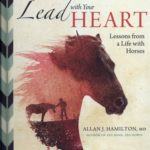In this nine-part series, I’m going to tell you about eight common trail terrors your horse might encounter – and what to do if the possibilities become reality. Then, I’ll tell you if you’re inadvertently putting your horse at risk for each terror – and how to minimize those risks. Use my field guide, and you’ll be able to safely handle these emergencies, perhaps turning a would-be disaster into only a minor setback.

I’m going to assume you know how to monitor your horse’s vital signs. I recommend that you get in the habit of riding with a running watch, or one with a second hand, so you can effectively monitor these signs. I’ll also assume you always follow trail riding’s first rule of safety: You never hit the trail without a riding buddy. Ready? Let’s ride.
First Aid Kit
To handle the emergencies I’ll tell you about soon, you’ll need to carry a complete trail first aid kit – and know how to use each item in it. This list of must-haves can help you cope with the most common emergencies you’re likely to encounter, but won’t weigh you down – you can pack it all into a small cantle bag:
Item #1
Bandaging materials:
Two sheet cottons
10 4″ x 4″ gauze pads
1 roll brown gauze
1 roll Vetrap
1 roll self-adhesive elastic tape
What it does
Provides support/ protection to lower limb.
When to use it
Wounds, Lameness
How to use it
Apply pressure wrap ober full-thickness skin wounds using 4-inch square gauze pads for pressure. Use all layers (2 sheet cottons, brown gauze, Vetrap, and self-adhesive elastic tape) to provide support for a tendon/ ligament strain, or suspected fracture.
Item #2
Betadyne solution
What it does
Antiseptic solution for killing bacterial organisms and cleansing tissues.
When to use it
Wounds, Lameness, Snakebites
How to use it
For flushing wounds, dilute with fresh, clean water (10 parts water to 1 part Betadyne).
For sanitizing a wound, apply directly, full strength.
Item #3
12 or 20 cc needleless syringes
What it does
Use to flush wounds with Betadyne solution.
When to use it
For Wounds, Lameness, Snakebites
How to use it
Fill with Betadyne solution: rapidly depress plunger to create pressure for cleansing dirty wounds. Repeat process until wound appears clean.
Item #4
Equine rectal thermometer, with string/ clip
What it does
Monitors horse’s body temperature.
When to use it
Heatstroke
How to use it
Shake down thermometer; insert in rectum; affix clip to tail. After 3 minutes, remove and read temperature.
Item #5
Saline solution (Tip: A small bottle of saline designed for contact-lens wearers can be purchased at any pharmacy.)
What it does
Cleanses eyes to help eliminate irritation. Can also be used to cleanse wounds.
When to use it
Eye injury, Wounds
How to use it
Drop liberal amounts directly into irritated/ injured eye; squirt directly into wounds to cleanse tissues.
Item #6
Antibiotic ophthalmic solution
What it does
Protects injured eyes/ wounds from infection.
When to use it
Eye injury, Wounds
How to use it
Apply directly to eye or wound.
Item #7
Banamine
What it does
Reduces inflammation/ pain (most effective for internal pain or eye pain).
When to use it
Colic, Eye injury
How to use it
Administer either oral paste or powder, or through an intramuscular injection. Average dose for 1,000 pound horse is approximately 500 mg.
Item #8
Phenylbutazone (“bute”)
What it does
Reduces inflammation/ pain (most effective for musculoskeletal injuries).
When to use it
Tying up, Wounds, Lameness, Allergic reactions
How to use it
Administer orally at approximate dose of two 1-gram tablets for a 1,000-pound horse. (Also available in paste form.)
Item #9
Xylazine/ butorphanol
What it does
Tranquilizer/ pain reliever.
When to use it
Colic, Tying up
How to use it
Intermuscular injection. (Note: Inject neck on tying-up horse.) Consult vet for appropriate dosage.
Item #10
Dexamethasone
What it does
Potent anti-inflammatory; counteracts allergic response.
When to use it
Allergic reactions
How to use it
Administer oral powder or intramuscular injection. Consult with your vet for appropriate form/dosage.
Item #11
Electrolytes
What it does
Helps restore electrolyte balance.
When to use it
Heatstroke
How to use it
Administer oral paste/powder as recommended on product label.
Item #12
Snakebite kit
What it does
Provides items necessary for handling a snakebite.
When to use it
Snakebite
How to use it
Comes with complete instructions.
Item #13
Two 6″ length of garden hose
What it does
Allows horse to breathe when air passages swell shut.
When to use it
Snakebite
How to use it
Gently insert into nostrils if nose swells. Swelling will hold them in place; they will drop out when swelling recedes.
Click here for more articles on Trail Riding First Aid.
Barb Crabbe, DVM, is a contributing editor at Horse & Rider. She is an Oregon-based equine practitioner.
This article originally appeared in Horse & Rider magazine.







